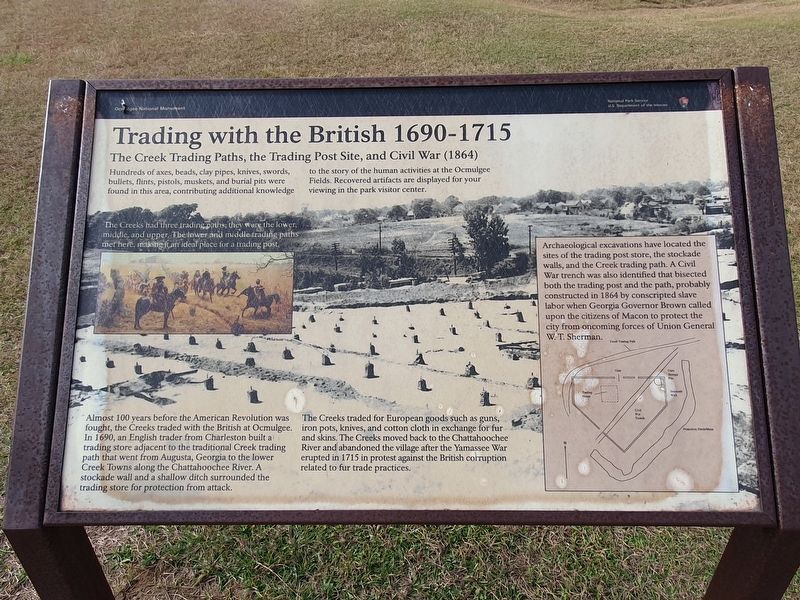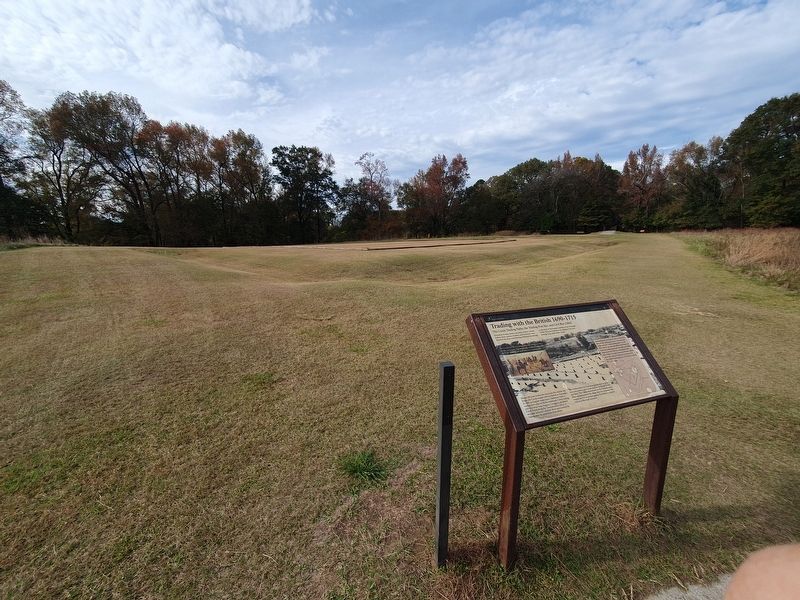Macon in Bibb County, Georgia — The American South (South Atlantic)
Trading with the British 1690-1715
Ocmulgee National Monument
Trading with the British 1690-1715
The Creek Trading Paths, the Trading Post Site, and Civil War (1864)
Hundreds of axes, beads, clay pipes, knives, swords, bullets, flints, pistols, muskets, and burial pits were found in this area, contributing additional knowledge to the story of the human activities at the Ocmulgee Fields. Recovered artifacts are displayed for your viewing in the park visitor center.
The Creeks had three trading paths; they were the lower, middle, and upper. The lower and middle trading paths met here, making it an ideal place for a trading post.
Almost 100 years before the American Revolution was fought, the Creeks traded with the British at Ocmulgee. In 1690, an English trader from Charleston built a trading store adjacent to the traditional Creek trading path that went from Augusta, Georgia to the lower Creek Towns along the Chattahoochee River. A stockade wall and a shallow ditch surrounded the trading store for protection from attack.
The Creeks traded for European goods such as guns, iron pots, knives, and cotton cloth in exchange for fur and skins. The Creeks moved back to the Chattahoochee River and abandoned the village after the Yamassee War erupted in 1715 in protest against the British corruption related to fur trade practices.
Archaeological excavations have located the sites of the trading post store, the stockade walls, and the Creek trading path. A Civil War trench was also identified that bisected both the trading post and the path, probably constructed in 1864 by conscripted slave labor when Georgia Governor Brown called upon the citizens of Macon to protect the city from oncoming forces of Union General W.T. Sherman.
Erected by National Park Service.
Topics. This historical marker is listed in these topic lists: Colonial Era • Industry & Commerce • Native Americans • Wars, Non-US • Wars, US Indian. A significant historical year for this entry is 1690.
Location. 32° 50.323′ N, 83° 36.434′ W. Marker is in Macon, Georgia, in Bibb County. Marker can be reached from Park path north of Ocmulgee National Park Road, in the median. Touch for map. Marker is in this post office area: Macon GA 31217, United States of America. Touch for directions.
Other nearby markers. At least 8 other markers are within walking distance of this marker. Muscogee (Creek) 1600-1826 (about 300 feet away, measured in a direct line); Mississippian Period 900 - 1600 (about 500 feet away); The Great Temple Mound and Town Site (about 500 feet away); Paleo Indian Period 15000 B.C.E. - 8000 B.C.E. (about 700 feet away); The "Iron Horse" devastates the mounds (approx. 0.2
miles away); Southeast Mound (approx. 0.2 miles away); Ocmulgee's Earth Lodge - America's Oldest Ceremonial Lodge (approx. 0.2 miles away); Cornfield Mound and Prehistoric Trenches (approx. 0.2 miles away). Touch for a list and map of all markers in Macon.
Credits. This page was last revised on April 6, 2024. It was originally submitted on April 6, 2024, by J. Makali Bruton of Accra, Ghana. This page has been viewed 39 times since then. Photos: 1, 2. submitted on April 6, 2024, by J. Makali Bruton of Accra, Ghana.

